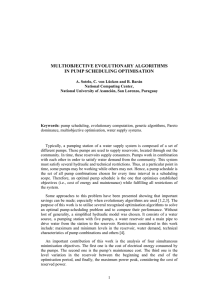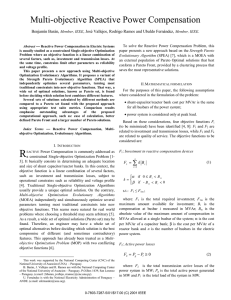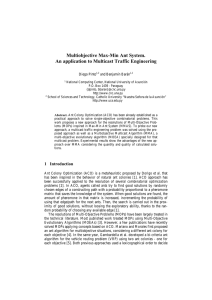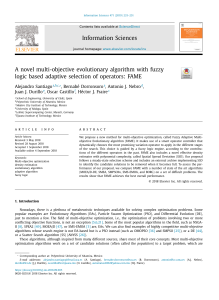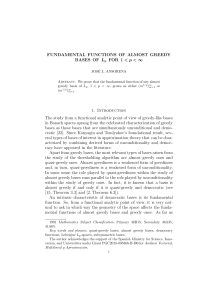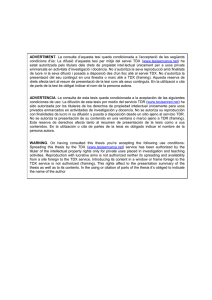New results for the multi-objective sequence dependent - SOA
Anuncio
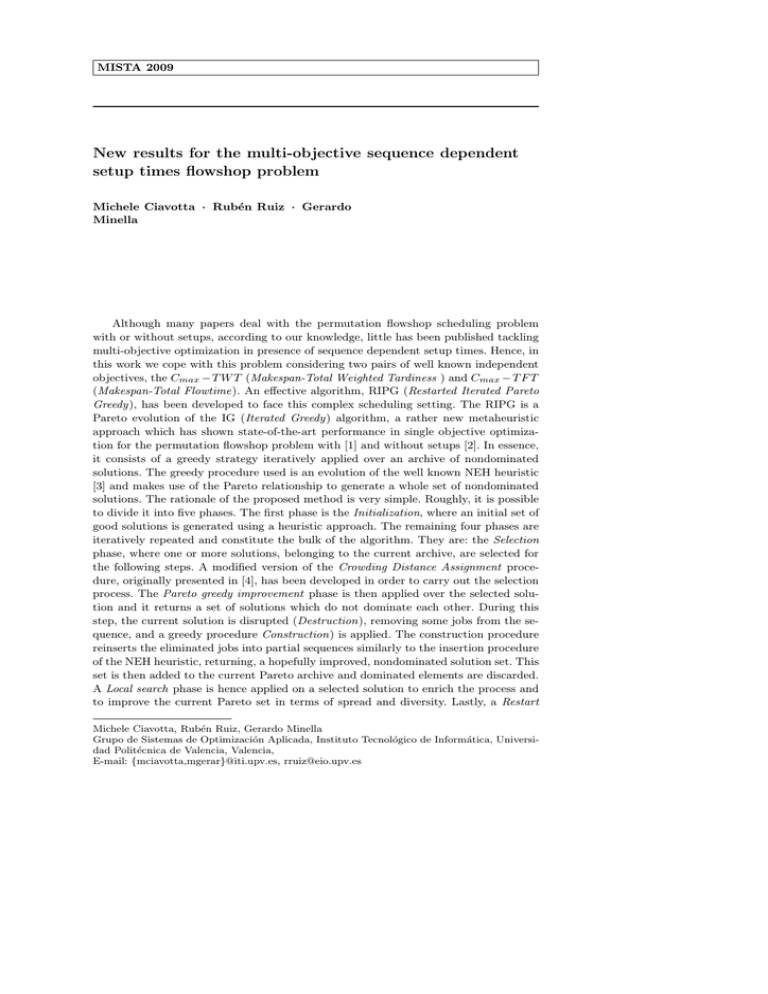
MISTA 2009
New results for the multi-objective sequence dependent
setup times flowshop problem
Michele Ciavotta · Rubén Ruiz · Gerardo
Minella
Although many papers deal with the permutation flowshop scheduling problem
with or without setups, according to our knowledge, little has been published tackling
multi-objective optimization in presence of sequence dependent setup times. Hence, in
this work we cope with this problem considering two pairs of well known independent
objectives, the Cmax − T W T (Makespan-Total Weighted Tardiness ) and Cmax − T F T
(Makespan-Total Flowtime). An effective algorithm, RIPG (Restarted Iterated Pareto
Greedy), has been developed to face this complex scheduling setting. The RIPG is a
Pareto evolution of the IG (Iterated Greedy) algorithm, a rather new metaheuristic
approach which has shown state-of-the-art performance in single objective optimization for the permutation flowshop problem with [1] and without setups [2]. In essence,
it consists of a greedy strategy iteratively applied over an archive of nondominated
solutions. The greedy procedure used is an evolution of the well known NEH heuristic
[3] and makes use of the Pareto relationship to generate a whole set of nondominated
solutions. The rationale of the proposed method is very simple. Roughly, it is possible
to divide it into five phases. The first phase is the Initialization, where an initial set of
good solutions is generated using a heuristic approach. The remaining four phases are
iteratively repeated and constitute the bulk of the algorithm. They are: the Selection
phase, where one or more solutions, belonging to the current archive, are selected for
the following steps. A modified version of the Crowding Distance Assignment procedure, originally presented in [4], has been developed in order to carry out the selection
process. The Pareto greedy improvement phase is then applied over the selected solution and it returns a set of solutions which do not dominate each other. During this
step, the current solution is disrupted (Destruction), removing some jobs from the sequence, and a greedy procedure Construction) is applied. The construction procedure
reinserts the eliminated jobs into partial sequences similarly to the insertion procedure
of the NEH heuristic, returning, a hopefully improved, nondominated solution set. This
set is then added to the current Pareto archive and dominated elements are discarded.
A Local search phase is hence applied on a selected solution to enrich the process and
to improve the current Pareto set in terms of spread and diversity. Lastly, a Restart
Michele Ciavotta, Rubén Ruiz, Gerardo Minella
Grupo de Sistemas de Optimización Aplicada, Instituto Tecnológico de Informática, Universidad Politécnica de Valencia, Valencia,
E-mail: {mciavotta,mgerar}@iti.upv.es, [email protected]
procedure is implemented to prevent the algorithm from getting stuck in local optima.
In this work we compare our algorithm against the highest performing approaches (especially those proposed for the multi-objective flowshop problem). In [5] a large number
of papers dealing with multi-objective flowshop algorithms have been reviewed and the
best performing ones have been also implemented. Starting from this point, we first reduced the number of methods by means of a preliminary test on a small set of instances
and, depending on the results obtained, we selected the ten best algorithms. Notice
that such methods also show the best performance for multi-objective permutation
flowshop without setups. During this preliminary phase we noted that the algorithm
proposed by [6] (MOSA Varad) achieved worse results with respect to the others, because it is not able to fully exploit the available CPU time. Therefore, we decided to
implement an improved version of this method (which we refer to as MOSA Varad M).
In [7] a promising algorithm (MOIGS) has been recently proposed and we decided to
implement and evaluate.
In all the experiments that we present in this work, we make use of two different instance
sets (SDST50 and SDST125), presented in [2]. Each set contains 110 instances with
several combinations of the number of jobs n and number of machines m. The n × m
combinations are: {20, 50, 100} × {5, 10, 20}, 200 × {10, 20}. Setup times are selected to
be respectively 50% and 125% of the processing times (pij ). As regards the performance
measures, the comparison of two different Pareto approximations is not straightforward.
However, recent studies point out how the so-called “Pareto-compliant” measures (see
[8, 9]) seem to be the most appropriate. Among these, we selected the hypervolume
(IH ) and the multiplicative unary epsilon (Iε1 ) indicators which represent the state-ofthe-art as far as quality indicators are concerned (for more details on the application
of these measures to multi-objective flowshop problem see [5]).
The stopping criterion for all algorithms is given by a time limit that is not fixed but
depends on the size of the considered instance. The algorithms are stopped after a CPU
running time of n · m/2 · t milliseconds, where t is an input parameter. In this way we
can assign more time to larger instances that are, obviously, more time consuming. Every algorithm is run 10 different independent times (replicates) on each instance with
two different stopping criteria: t = 150 and t = 200 milliseconds. A total of 114,400
data points are collected (13 tested algorithms × 220 instances × 10 replicates per
instance × 2 different stopping time criteria × 2 pairs of objectives). Actually, each
data point is an approximated Pareto front containing a set of vectors with the two
objective values.
Table 1 contains average results for (SDST125) instance set and (Cmax − T W T ) as
objectives. Although each depicted value is attained by means of a very large number
of samples, it is still necessary to carry out a comprehensive statistical experiment to
assess if the observed differences in the average values are statistically significant. A
total of 32 different experiments are carried out. We did parametric ANOVA analyses
as well as non-parametric Friedman rank-based tests on both quality indicators and
for the two different stopping criteria. The utility of using both parametric and nonparametric tests consists in improving the soundness of our conclusions. We carried out
16 (8 for each couple of objectives) multi-factor ANOVAs where the type of instance
is a controlled factor. The algorithm is another controlled factor with 13 levels. The
response variable on each experiment is either the hypervolume or the epsilon indicator. Lastly, there is one set of experiments for each stopping time. All the tests are
carried out with confidence level α = 0.05. Considering that each experiment contains
14,300 data points, the three main hypotheses of ANOVA: normality, homoscedasticity
and independence of the residuals are easily satisfied. To compare results, a second set
of 16 experiments are performed. In this case, non-parametric Friedman rank-based
tests are carried out. Since there are 13 algorithms and 10 different replicates, the results for each instance are ranked between 1 and 130. All these tests proved that IPG
widely outperforms all other algorithms for both hypervolume (IH ) and epsilon indicators (Iε1 ). As a consequence, IPG can be considered the state-of-art for this important
scheduling problem.
SDST125
Time
150
#
Method
IH
1
2
3
4
5
6
7
8
9
10
11
12
13
RIPG
MOIGS
MOGALS Arroyo
MOSA Varad M
MOTS
PESAII
PESA
MOSA Varad
PGA ALS
PILS
MOGA Murata
ε−NSGAII
CMOGA
1.307
1.194
0.980
0.939
0.930
0.923
0.922
0.853
0.840
0.776
0.737
0.679
0.669
Iε1
200
Method
1.077
RIPG
1.171
MOIGS
1.271 MOGALS Arroyo
1.348 MOSA Varad M
1.318
MOTS
1.267
PESAII
1.264
PESA
1.404
MOSA Varad
1.354
PGA ALS
1.410
PILS
1.389 MOGA Murata
1.419
ε−NSGAII
1.422
CMOGA
IH
Iε1
1.322
1.207
0.993
0.949
0.938
0.936
0.933
0.847
0.842
0.81
0.747
0.688
0.686
1.067
1.160
1.260
1.344
1.312
1.262
1.259
1.408
1.352
1.385
1.384
1.416
1.413
Table 1 Results for Cmax − T W T criteria and SDST125 instance set.
References
1. Ruiz, R., Stützle, T.: An iterated greedy heuristic for the sequence dependent setup times
flowshop problem with makespan and weighted tardiness objectives. European Journal of
Operational Research 87(3), 1143–1159 (2008)
2. Ruiz, R., Stützle, T.: A simple and effective iterated greedy algorithm for the permutation
flowshop scheduling problem. European Journal of Operational Research 177(3), 2033–2049
(2007)
3. Nawaz, M., Enscore, J.E.E., Ham, I.: A heuristic algorithm for the m machine, n job
flowshop sequencing problem. Omega-International Journal of Management Science 11(1),
91–95 (1983)
4. Deb, K.: A fast and elitist multiobjective genetic algorithm: NSGA-II. IEEE Transactions
on Evolutionary Computation 6(2), 182–197 (2002)
5. Minella, G., Ruiz, R., Ciavotta, M.: A review and evaluation of multiobjective algorithms
for the flowshop scheduling problem. INFORMS Journal on Computing 20(3), 451–471
(2008)
6. Varadharajan, T., Rajendran, C.: A multi-objective simulated-annealing algorithm for
scheduling in flowshops to minimize the makespan and total flowtime of jobs. European
Journal of Operational Research 167(3), 772–795 (2005)
7. Framinan, J., Leisten, R.: A multi-objective iterated greedy search for flowshop scheduling
with makespan and flowtime criteria. OR Spectrum 30, 787–804(18) (2008)
8. Zitzler, E., Thiele, L.: Multiobjective evolutionary algorithms: A comparative case study
and the strength pareto approach. IEEE Transactions on Evolutionary Computation 3(4),
257–271 (1999)
9. Zitzler, E., Thiele, L., Laumanns, M., Fonseca, C.M., da Fonseca, V.G.: Performance assessment of multiobjective optimizers: an analysis and review. IEEE, Transactions on
Evolutionary Computation 7(2), 117–132 (2003)
